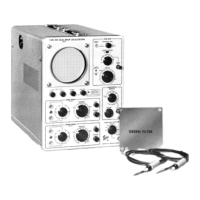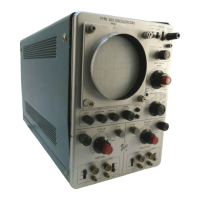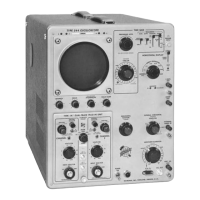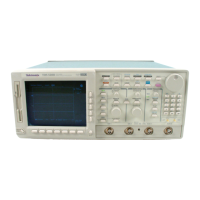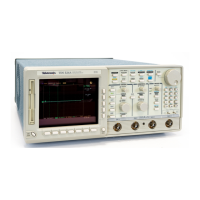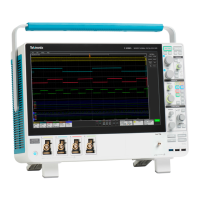Operating
Instructions—
51 03N
1
1 .
Multiply the measured distance
by the setting of
the
Seconds/Div switch.
EXAMPLE:
Assume
that
the
Seconds/Div
switch
is
set
to
50
jus
and the horizontal
distance
between
measurement
points is four
divisions.
Using the formula:
_
^
.
Seconds/Div
horizontal
distance
Time Delay
=
X
setting
(divisions)
=
(50
jus)
(4)
=
200
jus.
The time
delay is 200
microseconds,
i
Multi-Trace Phase Difference Measurement
Phase comparison between
two or
more signals of
the
same frequency can be made using a dual-trace plug-in
or
two single-trace plug-ins. This method
of
phase difference
measurement can be used up to the
frequency
limit of the
vertical
system.
To make the comparison,
use the
following
procedure:
1.
Set
the Input
Coupling switches of the amplifier
channels
to
either
AC
or
DC.
2.
Set the Display Mode switch on the time-base
unit
to
either Chop or
Alt. In
general. Chop
is
more
suitable for
low-frequency signals and the Alt position
is
more
suitable
for
high-frequency signals. More information
on deter-
mining
the mode is given under Vertical Display Mode
in
this section.
Fig. 2-7.
Measuring
phase difference.
7. Set the
time-base
triggering
controls
to
obtain
a
stable
display.
Set the
Seconds/Div
switch
to a sweep
rate
which
displays
about
one cycle of
the
waveform.
8. Move
the
waveforms
to the
center
of the
graticule
with
the
vertical Position
controls.
9.
Turn the
Variable Seconds/Div
control
until one
cycle of the reference
signal (Channel
1)
occupies exactly
eight
divisions
between the
second and tenth
vertical lines
of the
graticule
(see Fig. 2-7). Each
division of
the graticule
represents
45°
of
the
cycle
(360°
+
8 divisions
=
45°/
division).
The
sweep rate
can be stated
in terms of
degrees
as
45°/division.
3.
Set the
Triggering Mode switches
to trigger the
dis-
play on Channel
1
(or Left plug-in).
10.
Measure
the horizontal
difference
between
corres-
ponding
points on the
waveforms.
4.
Connect the
reference signal
to the Channel
1 input
connector
and the
comparison
signal to the Channel
2 input
connector.
The
reference signal should
precede the com-
parison signal in
time.
Use coaxial cables or
probes which
have similar time-delay characteristics to connect the
signals
to
the input connectors.
11.
Multiply
the
measured distance
(in
divisions) by
45 /division
(sweep rate)
to obtain
the
exact
amount
of
phase
difference.
EXAMPLE:
Assume a horizontal
difference of
0.6
divi-
sion with
a sweep rate of
45°/division
as shown
in Fig.
2-7.
Using the
formula:
5.
If
the
signals are of opposite polarity, push
the Invert
button
to
invert the Channel 2 display. (Signals
may be of
opposite polarity due to
180°
phase
difference; if
so, take
this into
account in the
final calculation.)
horizontal
Phase
Difference=
difference
X
(divisions)
sweep
rate
(degrees/
division)
6.
Set the Volts/Div
switches and the Variable
Volts/Div
controls
so
the displays are equal and about five
divisions in
amplitude.
=
(0.6)
(45°)
The
phase
difference
is
27°.
27°
2-10

